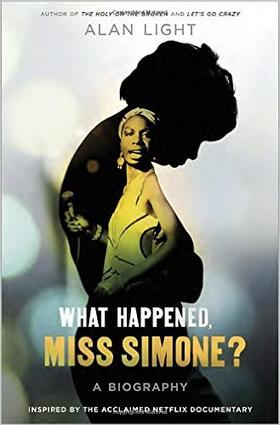Nina Simone Biography

The title of this life story, “What Happened, Miss Simone?” by Alan Light, is taken from a 1970 Maya Angelou quote speaking of her friend Nina Simone. Simone’s life was very complex–a story of potential unrealized and seeking an explanation. In this book you will find many causal attributes for her troubles—a very serious and neglectful travelling minister mother; a true love lost in adolescence never replaced; her own personality issues–depression and loneliness, etc. The book has strength for the testimonies of many who were close to her.
For the artist, the creativity seems to flow from the person naturally; but the artist performer must produce to make a living, and the commercial product is not as easily forthcoming. Nina hated to work; her husband/manager pushed her. She was financially supporting as many as nineteen people—family members, assistants, and her musicians. Stress existed in individual’s lives in the 1950’s as it does today. But, stress had not yet been defined as a psychological construct and people did not deal with it well. Early in her career Nina sometimes drank excessively and did recreational drugs. Also present was frequent loneliness, her sexuality was problematic, and relationships were strained. It all took its toll.
The civil rights movement gave Nina a path towards finding meaning in life and a new attitude in song. As a rising black celebrity she answered her people by supporting the movement; the songs “Mississippi Goddam,” “Pirate Jenny,” and “Four Women” became her anthems. Into the 1970s she shadowed the black power wave, counting Angela Davis and the widowed wife and daughters of Malcolm X as her confidantes. The decline of the movement in the mid-1970s marked a period of frustration in her life, and became another source of unhappiness. Simone responded by pursuing romance and liberation politics in places like Barbados and Africa. While realizing she was not to become the black female classical pianist as envisioned, she continued to cast herself as an intelligent performing artist. She scolded her Village Gate audiences with “pay attention to what I am saying.”
In writing this book, author Light accessed two sets of archived interviews. The first interview set was conducted by Stephen Cleary in 1989/1990 in preparation for his co-authoring Nina Simone’s brief and criticized memoir, “I Put a Spell On You.” Liz Garbus conducted interviews for a film documentary of Nina Simone in 2014; the transcripts from that project seem to be the primary source of material for this book. Interviewees for both sets include several European music fans who were to become Simone booking agents, managers, and personal assistants; several family members, writer Stanley Crouch, activist Dick Gregory, daughter Lisa Simone Kelly, the two Shabazz sisters, and Newport Jazz Festival promoter George Wein. Other source materials include Simone’s diary entries from 1961 to 1969 and letters written to husband/manager Albert Stroud during the same nine-year period. The numerous quotes from those who knew Simone make this book a success, enabling the active reader to draw one’s own interpretations of the complex human emotions and behaviors described within. Author Light provides the smooth bridging narrative linking interview revelations and Simone life events.
In interview, Dick Gregory explains what distinguished Simone from others in song, “’Mississippi Goddam’—that’s using God’s name in vain. We all wanted to say it, but she said it.” Gregory went on to speak of another’s courage, “Not one black man would say what Billie Holiday did about being lynched in ‘Strange Fruit’—they wasn’t lynching women, they was lynching men, but it was women that talked about it, and nobody told them to talk about it.” Stanley Crouch, speaking about the uniqueness of Simone’s talent and music, “She could bring deeper meaning to songs–that was her gift. She didn’t sing jazz, because in jazz you have to submit to the force of the band . . . she liked it to be about her . . . the human voice actually has greater freedom than any horn has.”
Nina Simone was a nomad—her list of residences included Tryon, NC (b. 1933); Asheville; New York City (three times); Philadelphia; Atlantic City (two summer-long engagements at Midtown Bar and Grill, 1952-53); Mt. Vernon, NY; Barbados; Liberia; Switzerland; Montreal; Paris; Guinea; Nijmegen, The Netherlands; Los Angeles; and Bouc-Bel-Air, France (d. 2003). Her cremation ashes were spread across several African countries.
Light, Alan. What Happened, Miss Simone? Crown Archetype: New York. 2016.
9(MDA3NDU1Nzc2MDEzMDUxMzY3MzAwNWEzYQ004))
Become a Member
Join the growing family of people who believe that music is essential to our community. Your donation supports the work we do, the programs you count on, and the events you enjoy.
Download the App
Download KUVO's FREE app today! The KUVO Public Radio App allows you to take KUVO's music and news with you anywhere, anytime!